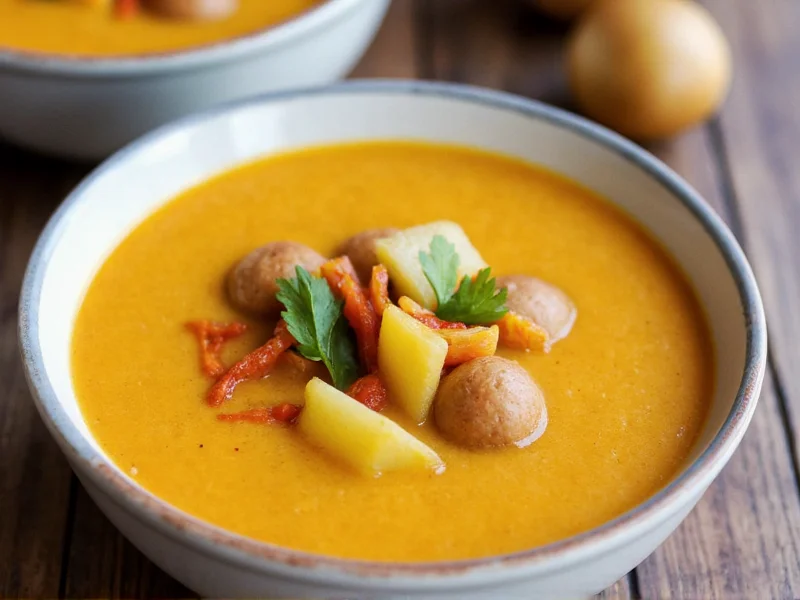The Science Behind Perfect Potato Soups
Potatoes contain amylopectin and amylose starches that release during cooking, naturally thickening soups. Russet and Yukon Gold varieties work best for creamy textures, while waxy potatoes like red bliss maintain shape for chunkier preparations. The key to avoiding gluey consistency is controlling cooking time—potatoes should simmer gently until just fork-tender, typically 15-20 minutes depending on cut size.
Global Potato Soup Traditions
Cultures worldwide have perfected potato soup recipes using local ingredients. Traditional Irish potato soup features cabbage and bacon, while French Potage Parmentier combines leeks with potatoes for a refined flavor profile. Russian Solyanka incorporates pickled elements for tanginess, and German Kartoffelsuppe often includes smoked meats and root vegetables. Each variation demonstrates how potatoes serve as a versatile base that absorbs surrounding flavors while contributing their distinctive earthy sweetness.
| Regional Variation | Key Ingredients | Distinctive Feature |
|---|---|---|
| Irish Colcannon | Potatoes, kale, scallions, bacon | Layered presentation with mashed potatoes |
| French Potage Parmentier | Potatoes, leeks, onions, vegetable stock | Creamy texture without dairy |
| Russian Solyanka | Potatoes, pickles, smoked meats, olives | Tangy, complex broth |
| German Kartoffelsuppe | Potatoes, carrots, celery, smoked sausage | Hearty, chunky vegetable profile |
Essential Techniques for Superior Potato Soups
Successful potato soup preparation requires attention to detail. Always start with cold water when boiling potatoes to ensure even cooking. For creamier textures without dairy, blend half the soup after cooking while leaving some chunks for texture. Acidic ingredients like lemon juice or vinegar should be added at the end to prevent potatoes from becoming mushy. When using dairy, temper it by adding small amounts of hot soup first to prevent curdling.
Dietary Adaptations for Modern Preferences
Traditional potato soups easily adapt to various dietary needs. For vegan versions, substitute vegetable broth for meat-based stocks and use coconut milk instead of dairy. Gluten-free preparation requires attention to thickeners—potato starch works better than flour for thickening. Low-sodium versions benefit from extra herbs and lemon zest to compensate for reduced salt. Adding leafy greens like kale or spinach boosts nutritional value without compromising the soup's comforting character.
Avoiding Common Potato Soup Mistakes
Many home cooks encounter issues with potato soups. Overcooking leads to disintegration and gluey texture—test potatoes with a fork starting at 15 minutes. Adding salt too early can make potatoes tough; wait until they're partially cooked. Using starchy potatoes in chunky soups results in breakdown—opt for waxy varieties instead. Finally, blending hot soup without proper venting causes dangerous pressure buildup—always leave space in the blender and cover with a towel.
Storage and Reheating Best Practices
Proper storage maintains potato soup quality. Cool soup completely before refrigerating in airtight containers for up to four days. When reheating, add small amounts of liquid as potatoes absorb moisture during storage. Freezing works well for most potato soups except those containing dairy, which may separate upon thawing. Thaw frozen soup overnight in the refrigerator before gentle reheating over medium-low heat to preserve texture.
Conclusion: The Enduring Appeal of Potato Soups
Potato soups remain beloved across cultures for good reason—they transform simple, affordable ingredients into deeply satisfying meals. Their versatility allows endless customization while maintaining comforting familiarity. Whether seeking traditional recipes or modern adaptations, understanding potato varieties and cooking techniques ensures consistently excellent results. The perfect potato soup balances creamy texture with distinct potato flavor, creating a dish that satisfies both hunger and soul.
Frequently Asked Questions
What's the best potato variety for creamy soup?
Russet and Yukon Gold potatoes work best for creamy soups due to their high starch content. Russets create the thickest texture, while Yukon Golds add natural buttery flavor. For optimal results, peel russets but leave Yukon Gold skins on for added nutrients and visual appeal.
How can I thicken potato soup without dairy?
Blend 1-2 cups of cooked soup until smooth, then return to the pot. Alternatively, create a slurry with potato starch and cold water, or add pureed white beans for creaminess with added protein. Simmering uncovered for 10-15 minutes also naturally thickens the soup through evaporation.
Why does my potato soup become gluey?
Gluey texture occurs when potatoes overcook or when using blenders improperly. Starchy potatoes break down excessively when boiled too long. To prevent this, cut potatoes uniformly, simmer gently until just fork-tender, and avoid over-blending. Adding acidic ingredients like vinegar too early also contributes to this problem.
Can I make potato soup vegetarian without losing flavor?
Absolutely. Use roasted vegetable broth as your base and add umami-rich ingredients like dried mushrooms, tomato paste, or soy sauce. Sautéing onions, garlic, and celery before adding liquids builds deep flavor. For meaty notes without actual meat, try smoked paprika or liquid smoke in small quantities.
How long does homemade potato soup last in the refrigerator?
Properly stored in airtight containers, potato soup remains fresh for 3-4 days in the refrigerator. Always cool soup completely before storing. When reheating, add a splash of broth or water as potatoes absorb liquid during storage. For longer preservation, freeze portions for up to 3 months.











 浙公网安备
33010002000092号
浙公网安备
33010002000092号 浙B2-20120091-4
浙B2-20120091-4